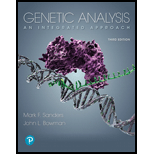
To analyze:
The aim of GWAS (Genome wide association studies) is to locate chromosome regions containing the genes influencing the risk of disease, when applied to the study of the human genome. Unique articular genes can be identified in these regions; especially mutant alleles that intensify disease risk are to be sequenced. So far, the recognition of these alleles occasionally led to a new therapeutic strategy, but more frequently the identification of disease alleles is the only outcome.
a. From a physician’s perspective, describe the importance of identification of these alleles that increase the risk of a specific disease.
b. Explain the importance of identifying alleles that increase disease risk for a person who is currently free of the disease but what about the persons having pre-disposal of this disease that is running in the family.
c. Describe the personal or ethical issues occured from GWAS, might be of concern to physicians or to those who may carry an allele that increases the risk of disease.
Introduction:
GWAS is designed for the detection and location of the genes that influence the appearance of the trait by multiple genes. These multiple genes responsible for a particular trait are dispersed throughout the genome. Hence, the GWAS helps to locate the particular gene in the genome.
GWAS does not create any gene map of a chromosome rather it finds the association of traits and the groups of alleles to locate these influencing genes on different chromosomes.
In the GWAS, the term association refers to the trait co-occurs with group of alleles more often than expected.
The GWAS connects the presence of DNA marker having sequence variation with quantitative trait loci (QTL) affecting the particular
Want to see the full answer?
Check out a sample textbook solution
Chapter 19 Solutions
Pearson eText Genetic Analysis: An Integrated Approach -- Instant Access (Pearson+)
- List three clinical indications for chromosome and/or genome analysis and why the process might be important for each indication.arrow_forwardWhy is it necessary to examine gene-expression profiles, in additionto genome sequences, for effective precision medicine?arrow_forwardPlease explain in detailarrow_forward
- a. Briefly discuss (using three sentences) how the concepts and/or techniques in molecular biology are applied in COVID-19 pandemic, and: b. For each topic (Covid-19 pandemic), give any issues, benefits, or drawbacks of the application (still using three sentences).arrow_forwardList three conditions for which gene therapy trials have been performed for, and suggest reasons for their successarrow_forwardExplain how site directed mutagenesis can be accomplished using M13 bacteriophage. Using this method often results in only 5% of plaques with mutant gene. Explain how the procedure has been modified to enrich for the number of plaques with the mutant gene.arrow_forward
- Microarray hybridization is used mostly in transcript profiling or assaying DNA variation. Although the technology for establishing DNA microarrays was developed only recently, numerous applications have already been developed and their impact on future biomedical research and diagnostic approaches is expected to be profound. Give some examples of the practical use of this technique.arrow_forwardGive a schematic diagram of how we can Treatment Down Syndrome by using gene therapy? Please answer at your own words,please..arrow_forwardDescribe three possible uses of site-directed mutagenesis.arrow_forward
- Describe some methods used to deliver normal genes to cells for gene therapy treatments.arrow_forwardGive a schematic diagram of how we can Treatment Down's syndrome by using gene therapy? Please answer at your own words,please..arrow_forwardThe MET oncogene is a growth factor receptor that is altered in many forms of cancer including lung and colon carcinomas as well as several forms of melanoma. One assay for characterizing the gene composition of tumor cells is Fluorescence in situ Hybridization (FISH) in which a fluorescently labeled DNA is used to show the presence of and level (i.e. number copies) of a gene inside cells. The experiment below is a FISH assay of two different tumor samples (Patient D and Patient E) using a MET gene probe labeled with a green fluorescent probe. The figure on the right presents the survival data from diagnosis of cancer patients with FISH data similar to Patient D or E. Based on this data, what has happened to the MET gene in Patient D population that has made their cancer more severe and reduced survival time (Limit 4-5 sentences). D Survival rate (%) 100 0 0 100 200 Time (days) 300 Earrow_forward
 Human Heredity: Principles and Issues (MindTap Co...BiologyISBN:9781305251052Author:Michael CummingsPublisher:Cengage Learning
Human Heredity: Principles and Issues (MindTap Co...BiologyISBN:9781305251052Author:Michael CummingsPublisher:Cengage Learning
